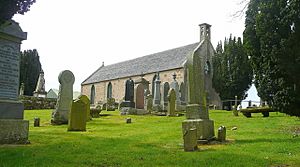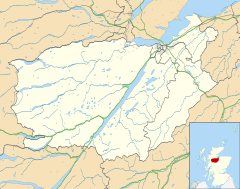Croy, Highland facts for kids
Quick facts for kids Croy
|
|
|---|---|
 Croy & Dalcross Parish Church |
|
| Population | 498 (2011 census) |
| OS grid reference | NH796495 |
| Council area | |
| Lieutenancy area | |
| Country | Scotland |
| Sovereign state | United Kingdom |
| Post town | INVERNESS |
| Postcode district | IV2 5 |
| Dialling code | 01667 |
| Police | Northern |
| Fire | Highlands and Islands |
| Ambulance | Scottish |
| EU Parliament | Scotland |
| UK Parliament |
|
| Scottish Parliament | |
| Website | Community Council |
Croy (in Gaelic: Crothaigh) is a small village in Scotland. It is located between the towns of Inverness and Nairn, within the Highland area. Croy offers views of the Moray Firth and is close to Inverness Airport. About 498 people lived here in 2011.
Discovering Croy's Past
Croy has a long and interesting history. Long ago, the area was home to the Picts. They were an ancient people who lived in Scotland. We know this because Pictish jewelry from around 800 AD has been found here. You can see some of these ancient treasures at the Inverness Museum and the National Museum of Scotland.
Kilravock Castle: A Historic Home
Just a short distance from Croy, about 1 kilometre (0.6 miles) away, stands Kilravock Castle. This castle has been the home of the Clan Rose family for centuries. The oldest part of the castle, a strong tower, was built in 1460. Later, in 1553, a large mansion was added, giving the castle its current look.
Famous Visitors to Kilravock Castle
Kilravock Castle has hosted important guests. In 1562, Mary, Queen of Scots visited the castle during her travels around Scotland. Much later, in 1746, two famous figures from Scottish history came to the castle. Prince Charles Edward Stuart, also known as Bonnie Prince Charlie, visited just before the Battle of Culloden. After his army lost the battle, Prince William, Duke of Cumberland also visited. The Rose family was known for their hospitality, treating both sides fairly.
Croy's Churches and Community Buildings
The local church in Croy was built in 1764. It is a typical Scottish Presbyterian church. It has a simple rectangular shape with a bell on one end. A nearby house for the minister, called the manse, was built in 1855.
The village hall in Croy was built in 1907. Local people helped raise money for it. They also received a grant from the Carnegie Library fund. The land for the hall was given by the Kilravock estate.
Remembering Local Heroes
Next to the village hall is a war memorial. It was put up in 1919 to remember 27 local people who died in the First World War. After the Second World War, 11 more names were added to honour those lost.
Life in Croy Today
Croy is a growing village. New homes have been built, and more are planned for the future. The community works together to make Croy a great place to live.
Community Activities and Services
The Croy & Culloden Moor Community Council represents the local area. They help run the village hall. Many local groups use the hall, including the 11th Inverness (Croy) Scouts.
While the village shop closed in 2014, the nearest shop is now in Cawdor, about 3 kilometres (1.9 miles) away. Croy has a primary school. Older students attend Culloden Academy.
Supporting Young People in the Area
Nearby, Cantraybridge College helps young adults with learning disabilities. They offer training for jobs in the countryside. The college also has a community café. This café gives young people with disabilities a chance to gain work experience.
Visiting Kilravock Castle Today
Kilravock Castle no longer offers bed and breakfast stays. The castle and its grounds are generally closed to the public. However, you can visit the gardens by leaving a donation. There are no staff for tours of the castle itself. The Kilravock Castle Christian Trust manages The Granary, which is a bunkhouse for youth groups. They also have the Rose Hall, which can be rented for events.
Local Transport and Worship
Croy & Dalcross Parish Church is the local Church of Scotland congregation. Services are held every Sunday at 12 noon. The church also has its own hall. Bus services connect Croy to Inverness during the week. There are no bus services on Sundays.
Notable People from Croy
- Gordon Campbell (1921-2005) - A politician who served as Secretary of State for Scotland. He lived on the nearby Holme Rose estate.
Images for kids









